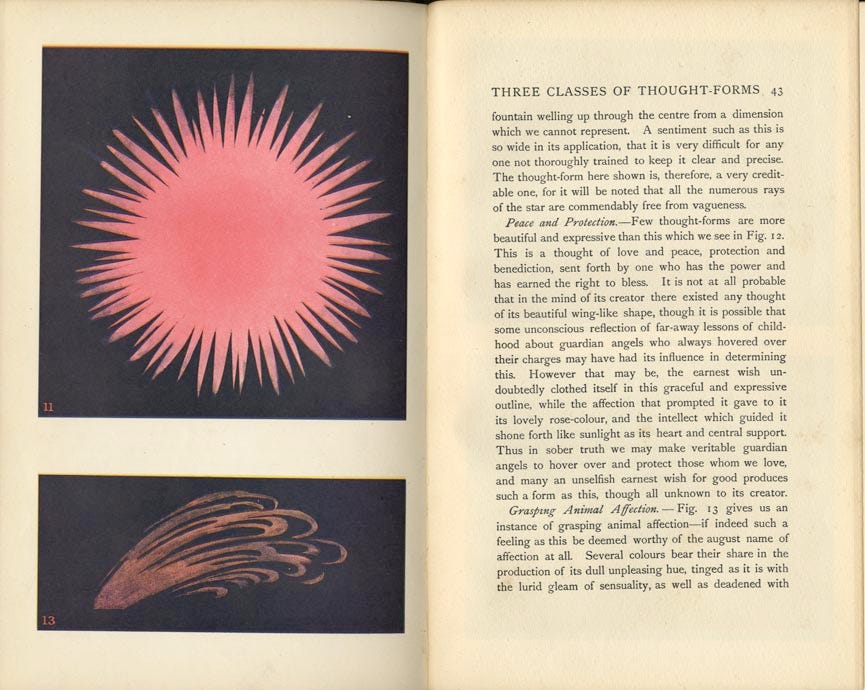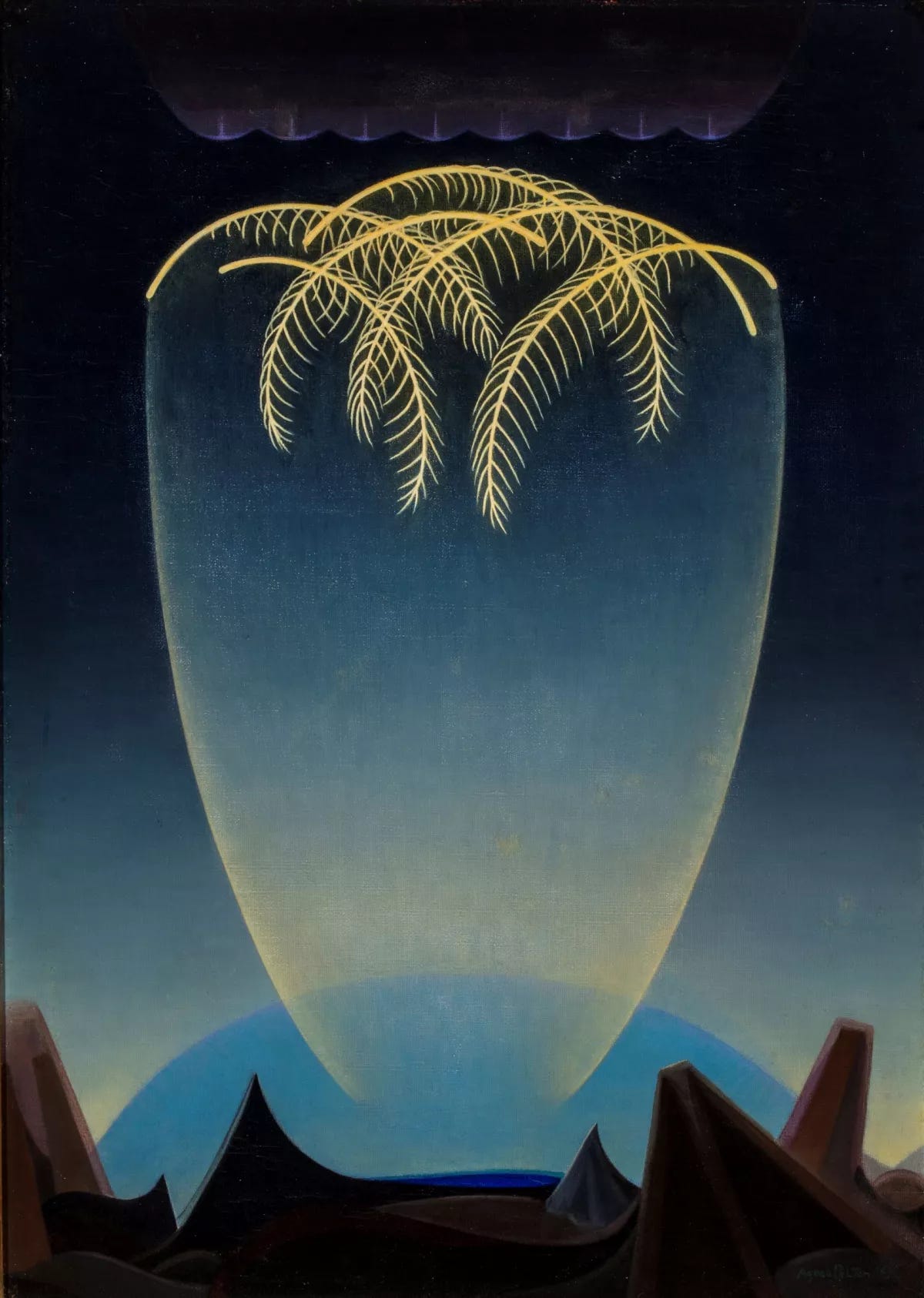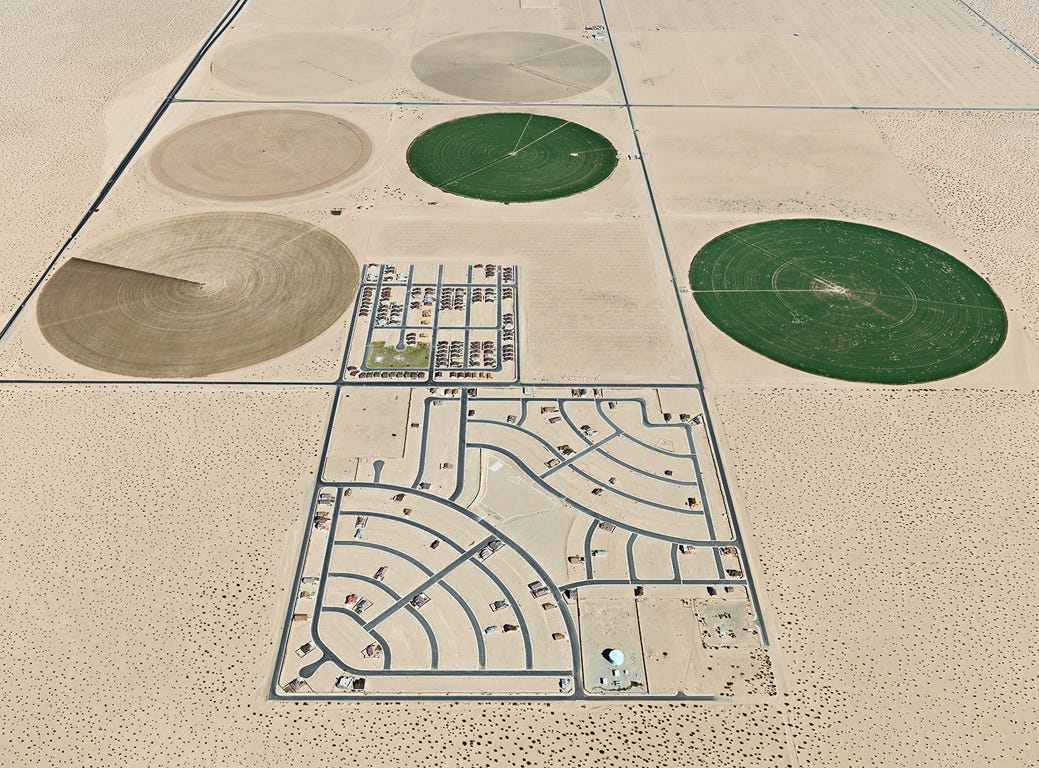Denial of Your Creativity Fuels Planetary Degeneration
Looking for Headwater: Rewilding Agency and Creative Life Force Energy
On the 3rd of April Headwaters 6-week long writing course begins! We will work through creative blocks and dive into authentic writing. You can find all the information about the course here. 𖦹
Reconciliation with your own creative energy is a deeply personal matter and an enduring, energetically potent process. But at the same time, it can be a rewarding initiation that induces your soul into a new lifepath, and new recognition of yourself. In the regenerative paradigm, this is the inner work that realigns us with our core-soul values. It’s what liberates our captive energy, and allows it to be directed towards projects and livelihood that can be deeply healing and re-energizing for us and for the earth. Let’s begin.
“Always do this work first, others only when these do not call you.”—Agnes Pelton, wrote in her diary, in the early 20th century. Pelton was a painter, often called the desert transcendentalist. Working under the deep influence of Eastern and Western mysticism, theosophy, and Jungian insight, the painter dedicated her life to artistically exploring the intersection of the living world’s symbolism, animism, and transcendentalism. Several years after her mother's death, at the age of 51, Agnes moved from the state of New York to a California desert town. Primarily, Pelton painted abstract paintings, pertaining to her inquiry into the invisible realm— ”impressions of visual experience, bringing out light out of darkness”, as she described. Landscape paintings, on the other hand, supported her financially, as she sold the canvases in Palm Springs markets for seasonal tourists and visitors of the town.
“This work first”—was the abstract paintings, where Pelton was able to direct her visions and craft towards the visual expression of the spirit realm. Feeling the tension between the natural and abstract direction in her art, after periods of devotion to landscape paintings, Agnes would return to the abstract work with renewed energy. In a letter to her friend, Pelton wrote: “It was like painting with a moth’s wing and with music instead of paint.”
I wrote the same statement in my notebook, “Always do this work first, others only when these do not call you”, hoping it would remind me of the essential nature of choice and prioritization—something that I have struggled with for a long time in my creative work.
I feel an affiliation with a painter that noted down that line a hundred years ago. Her life seemed ephemeral but true. Notes from her letters and inscriptions in her notebooks feel resonant, and somehow timeless. Perhaps, there is timelessness in devoting your life’s work to landscape, mysticism, and transcendence. Even though for most of her life Pelton struggled financially, she managed to find a way to always come back to the most important, most significant work. That to me is a cue, a signal, an activating message.
There’s something about putting forward your creative vision and voice despite inner and outer resistance. A certain non-negotiability and prevalence. Call it a weed, re-growing in a garden—perseverance, and belief in your own work.
But why does it take so long to hear this part of ourselves? Why do we resist that inner voice that has the capacity to transform us into the truest versions of ourselves?

Like a prey bird, for the past months, I’ve been circling around one thought:
My refusal to recognize my creative energy as the most valuable thing in my life.
This might sound narcissistic. You might ask: “m0st vAluAble tHinG in y0Ur liFe?!”
I don’t want to assume what is the most valuable thing in your life. But I want to explore what we miss out on in plain sight. I want to explore something that is in front of our eyes but that we do not recognize or refuse to recognize. Our creative life force energy and its value.
Here, I speak for myself, not for the general public. There might be many people who already recognize the intrinsic value of their creative energy and take full stride in its manifestation. But if you are on the fence and this resonates, I invite you to go down the rabbit hole with me.
Creativity can take many shapes and forms, and slide under your door—unnoticed and unrecognized—like the wind from The Waste Land by T. S. Eliot:
“What is the noise?”
The wind under the door.
“What is that noise now? What is the wind doing?”
Nothing again nothing.
“Do
“You know nothing? Do you see nothing? Do you remember“Nothing?”
I remember
Those are pearls that were his eyes.
“Are you alive, or not? Is there nothing in your head?” Dreaming the wrong dream
We devalue our creative energy because we have been socialized to devalue it. I want you to imagine tracing your energy across a stream, the way we would trace a river. Where and when is your energy generated? And when you are working on something, where does it end up? When I did this tracing visualization a year ago, I saw my energy ultimately flow into some unknown investor’s portfolio. It was strange to recognize that producing something creative one day, could ultimately be fueling a degenerative system I am hoping to shift.
In its simplest form extraction refers to the removal of something, and of someone claiming it for utilisation elsewhere. ‘It’ might be material, energy, labour, or knowledge; human, non-human, or non-living. Extraction becomes a violent operation with scale and disconnection. — Anthony Powis for MOULD
A person can grow up being taught that a mountain is just a pile of rock, ready to be mined. Another person can grow up, taught that the mountain is an apu deity, able to direct their destiny. And the question isn’t about whether a mountain is a pile of rock or a life-altering spirit, but how these beliefs manifest themselves in culture— with profoundly different ecological consequences. The lens through which we see reality is the one that also creates and reinforces that reality
An interesting thing happens when we are worlded into devaluation of our own creativity, energy, and potential. We unconsciously agree to that devaluation and assume roles, positions, and work that maintains us in that paradigm. This devaluation opens a valve for our energy and creativity to flow downstream into someone else’s profit and possibly to further the growth of degenerative systems.
The way we exploit Earth’s resources is the way we exploit our own energy and creativity. We separate and displace ourselves from it. We exile ourselves from our life’s work because we question our enoughness. We refuse to recognize the value of our creative potential.
“We can recognize that this deformation of new potential is taking place when we begin to question our ability, and especially our legitimacy to think, or act, or be.“
— Women Who Run With the Wolves, Clarissa Pinkola Estés
The extractive economy thrives on value displacement and misrecognition. It thrives on a collective dream of unworthiness, illegitimacy, and shrunken agency.
I ask myself:
Are we dreaming the wrong dream?
I recognize how collective and personal trauma around self-efficacy and agency fuels the extractive system. Extractivism generates trauma not only in people and more-than-human beings but also in landscapes: it creates layers of generational fragmentation and inconsolable memories. The extractive paradigm also expects you to heal that trauma, and come back to the system as a well-functioning member of society. And it pathologizes everyone who takes time or refuses to do so.
But what if the body and the psyche refuse to heal? Refuse to be treatable, refuse to heal back into the way the extractive world asks you to show up: productive, useful, resourceful, agile, and creative—for the sake of the system. When whatever healing journey we embark on and our physical, spiritual, and mental conditions do not change.
What if there is a part of you that refuses to dream this collective dream because it knows the true value of your creative life force energy? What if there is a part of you that refuses to be treatable until you listen to the true intention of resistance? This part of you knows your true self-expression and your true name.
In the poem The Soul Lives Contented by Listening, David Whyte externalizes his own resistance to becoming a poet—transforming into a terrifying new shape:
The soul lives contented by listening. If it wants to change into the beauty of terrifying shapes it tries to speak. That is why you will not sing, afraid as you are of who might join with you. The voice hesitant, her hand trembling in the dark for yours. She touches your cheek and says your name at the same time. The one you refused to say, over and over, the one you refused to say.
And so I ask, what is the name you refuse to say? In the early morning, unburdened, in nature. What is the name you refuse to say? When everything else is stripped down, when all the weight and pressure of the world is resting, sludged against the wall in deep sleep. When you gaze into the vast atlas of the dark sky, when you hear the first birdsong of the volatile arrival of spring—what is the name you refuse to say?
Thought Forms of Extraction
As I wrote earlier, way back at the beginning of the 20th century, there was a rising interest in integrating mysticism into the fine visual arts. Most of the famous painters of that era, including Agnes Pelton, Hilma af Klint, and Georgia O’Keeffe have read the book “Thought Forms” (1905), by Charles Webster Leadbeater and Annie Besant. This book made a big influence on the art world at that time, allowing artists to explore mysticism and the occult in their own work. (Interestingly enough, while writing this essay I learned that Leadbeater was a disciple of Madame Blavatsky— one of the figures of Western occultism in the late 19th century—later immortalized as Madame Sesostris in T.S. Eliot’s previously quoted poem The Waste Land.)
The book visualizes thought forms into visible, colorful images that express emotions and thoughts through visual dimensions. It speculates a synesthetic view of the world, where we can draw upon the invisible.

I wonder what extractivism would look like as a thought form visualized by 19th-century mystics. I wonder how the artists of that time would have chosen color and form to depict something that was already underway for centuries.
I want to recognize the extractive economy as a byproduct of extractive consciousness. I want to recognize it as a systemic pattern of thought. I see it as a thought, that has multiplied itself through space and time, finding collective and individual minds to come through. I imagine this thought as a void.
Can a void be visualized?
How do you visualize a state of being so far away from fulfillment and wholeness, a state of being that is fuelled by a deep sense of separation and loneliness? Loneliness that tells you: what you have will never be enough. Who you are will never be enough. The cities you have built, the wealth you have amassed, and the populations and cultures you have colonized and destroyed will never be enough to silence this hunger. The origins of this wound of loneliness are hard to trace back in time. It resides in each of us like mitochondria that found their way into a eukaryotic cell.
This void feeds itself through doubt and devaluation. Rests low in the pits of unblossomed self-esteem, and impaired personal and collective agency. A dream, embedded in reality, that feels just as real. A dream as big as a society.
This consciousness lives in our inner thoughts and feelings, and it also lives in silent agreements in boardrooms, high up in the sky-scraping buildings.
We are learning to with the trouble—but can we sit with the void?
And maybe this void is, ultimately, a void of love.
I cannot see the transformation in the economy, I cannot see us stopping the use of fossil fuels, or the erosion of forests and biodiversity if we do not heal the wound created by the absence of love.
How does the system heal itself, if not through tremors, if not through admitting its true needs? If not by shaking, trembling, and waving. Until then, whatever gets in its way will be used and extracted so that void can be filled. Until then our creativity will follow the coal mines, the oil spills, and the warming oceans. Until then our energy is extracted and misplaced into someone else’s profit and the degeneration of the Earth.
Because, if a person does not fundamentally believe in her own agency and the value of her creativity, she will not exercise it. She will give up her creativity as a workhorse for the extractive and degenerative economy.
She will see very little return on what she has given.
The world will see the remnants of her brilliance being wasted in-between Instagram posts, occasional poems, or unfinished paintings. The life force energy that begets her being on this earth will trickle into a silent grove, running into the vault of someone else’s profit. The banks of the river will lower. The estuary of her creativity will run dry.
And I am not concerned with money, I am concerned with the invisible nature of extractivism that separates creators from their creations. I am concerned with the way we exchange energy and the way energy moves from primary sources of abundance to places of captivity.
Let’s imagine: my energy at work is extracted and used to maximize the profit or growth of a company, which maximizes the ROI of its shareholders. The river reaches its captivity at the dam. The river starts generating energy not for the ecosystems within and outside of it, but for human benefit. So, for me to continue this path I will have to consume more, as my energy is not regenerated by my work. I will have to seek other sources outside of work to replenish my energy, only so I can continue working.
wrote in his essay Inverting the Energy Paradigm:Many of us today are reaching our limit. The condition called burnout mirrors the depletion of fossil fuels. But the solution to burnout is not to drink more coffee, or eat more food, or take better supplements. Nor is it to keep doing what we’ve been doing, only less of it. It is the same with fossil fuels: the solution is not to ramp up fracking to get more oil, nor is it supplementation with “renewables,” nor is it to use energy as before, only less of it (conservation). Burnout signals that the time has come to turn one’s energy toward different ends. That doesn’t mean that the old ends were wrong. It is that the time has come for a change.”
I feel an urgency. I see this perception transformation as the most crucial one, allowing us to induce a regenerative culture shift.
Visions of the Creative Futures
I am interested in a path that allows for receiving returns of our energy and creativity. Where our energy and creativity multiply and nourish our living and the rest of living systems. Where humans are empowered by their own agency and have a choice over where they pour their energy into. Energy like an elixir, growing, nourishing, and expanding whatever it touches. Energy like mycelium, finding the porosity in the finest cavities of clay and concrete, finding other roots and beings to connect and expand mutual care and nourishment.
In the book Prototyping 2040, the authors argue that by 2040, work will only be allowed if it serves the community. With the introduction of Universal Basic Income (UBI), work has become one of the primary sources of meaning and satisfaction—and not just the means to make a living. The alienation from work as we’ve known through the past centuries of the extractive economy is over.
Here, we can imagine the workplace is centered around the community being in service of the bioregion it is in. The work is interwoven with life, and more precisely, creativity is interwoven with everyday life. There is no work-life balance because our work is an expression of our agency and ingenuity. A natural desire to merge our lives with others’. A natural desire for our productivity to be in service of higher values, regeneration of the environment, creativity, and fortifying the weaves of community.
Even if UBI is introduced, it doesn’t mean that we automatically re-story our sense of purpose and meaning. Yes, it is true, we only have the privilege to contemplate meaning when we do not have to fight for our survival. When we are not preoccupied with putting food on our table and paying rent. But even then, money only solves half of the problem, by freeing people from poverty, Bullshit Jobs (David Graeber), or hourly-rate labor.
The other half belongs to shifting our relationship to creativity, meaning, purpose, and connection. Meaning is not introduced when a meaningless task is removed, nor it is bestowed upon us by someone else.
The other half belongs to reimagining our parenting, education, and collective stories (beliefs) that sustain the current economical structures. Stories that become invisible, as they spread through the collective unconscious. The bigger they get, the more invisible they become.
In the futures, I see awakening into perceiving creativity and agency as one of the highest virtues and values, in the context of work and community.
Can I value my creativity and agency enough to make that shift? To reclaim my creativity from the extractive economy and redirect it into art, work, community, relationships, and projects that symbiotically regenerate my energy.
Maybe many freelancers have figured it out already. Maybe the creator economy has figured it out already. Maybe business owners have figured it out already.
But I haven’t yet, and that is why I feel invigorated and fascinated by this topic.
I don’t have an answer, only questions.
Resolution
“Always do this work first, others only when these do not call you.”—what is this work for you?
A river flows downstream without debating. It carves and spreads itself across the landscape, inviting a place for aliveness to gather, grow, and prosper within and around it. A river is an architect, bearing life.
The river buds in the mountains and condenses itself to come through.
To come through.
Clarissa PinKola Estés draws an analogy of river as our creative life force energy. She calls it River Under River. She writes:
When the river is cleansed again it is free to flow; a woman's creative output increases and thereafter continues in natural cycles of increase and decrease and increase again. Nothing will be carried off or fouled for long. Whatever contaminants occur naturally are neutralized efficiently. The river retuns as our system of nourishment, one we can enter without fear, one we can drink from without worry, one beside which we can calm the tormented soul of La Llorona, healing her children and restoring them to her. We can dismantle the polluting process of the factory, seat a new animus. We can live our lives as we wish and as we see fit, there beside the river, holding our many babies in our arms, showing them their reflections in the clear, clear water.
The river rises to its own source—the headwater. It collects itself beneath the grunting ground, tiny streams rush barefoot to merge into one.
Every river has a headwater, a watering hole somewhere high up.
Headwater is a portal. Between the underground and overground—a melting space of transfiguration. This is where creativity condenses, swells, and emerges as a gift.
Where is your Headwater?
Your own river collects itself like an underground cloud and starts dripping upwards, bursting, breaking through the lithosphere—ready to create gravity of aliveness around itself, the way a star does.














I think J Krishnamurti's words here might be relevant “It is no measure of health to be well adjusted to a profoundly sick society.”
i love your stuff Rūta, if i would be limited to only following 1 newsletter, it would be yours